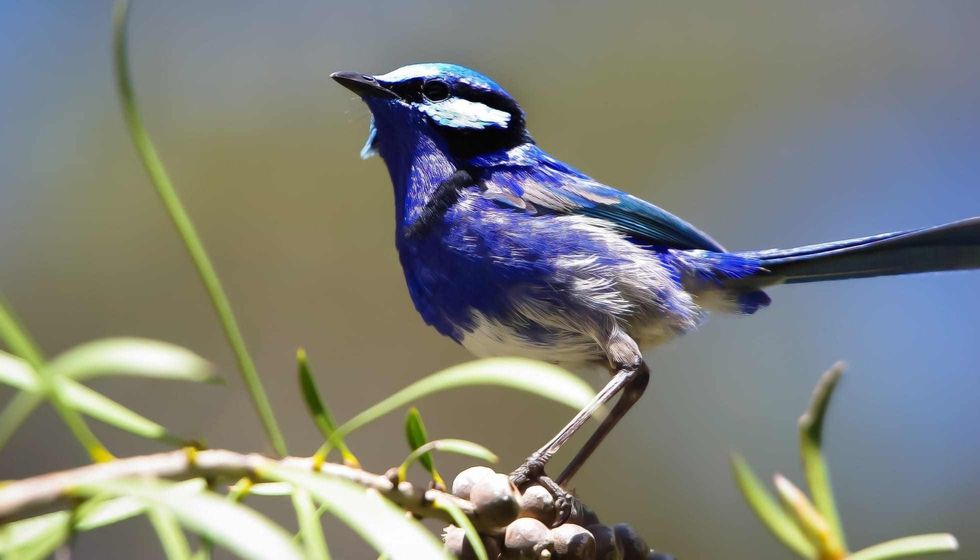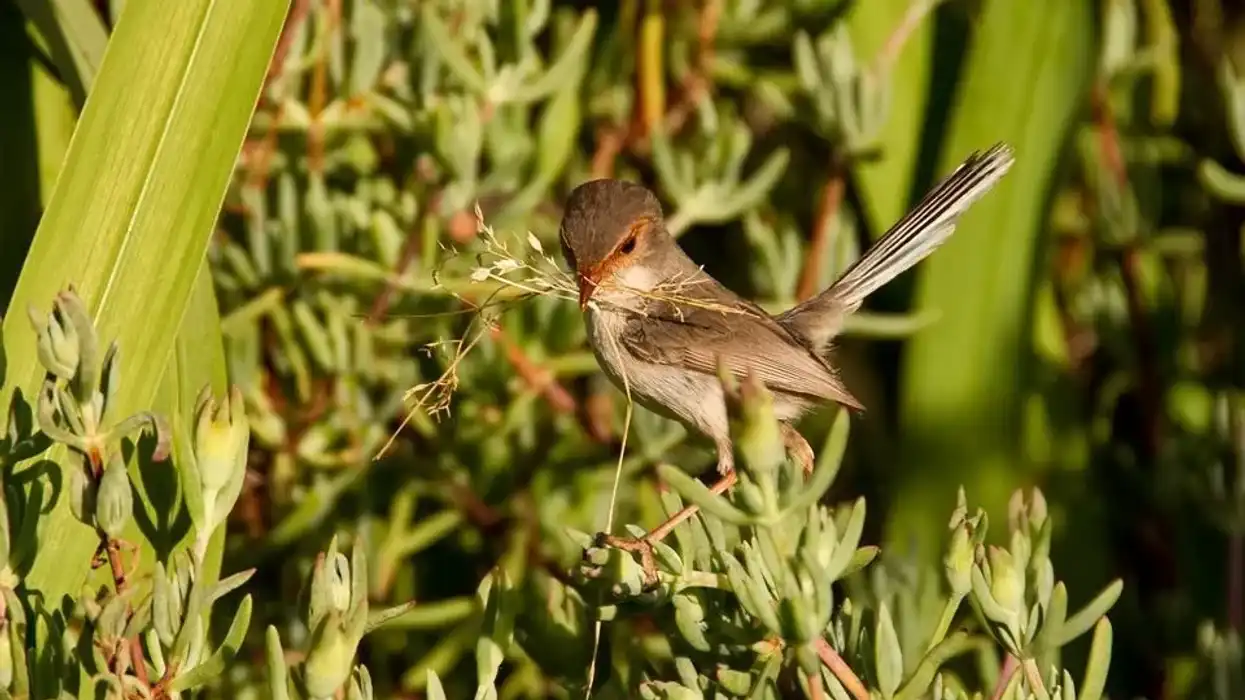Splendid fairy-wrens (Malurus Splendens) are small but adorable birds commonly found in Australia. The breeding males have a majestic plumage with a bright blue forehead and rich blue-back wings. The males' throats are violet-colored, and their bill is black. Their crown and cheek patches are paler blue, and they have brownish-gray legs and feet.
Splendid wrens have black bands on their breast and at the base of their blue tail. The female is similar to non-breeding males and has brown and blue wings alongside a white belly.
The only difference is that they have a chestnut bill and have a reddish-tan line from the beak to the eye that extends into a ring around their eye.
Another interesting fact about the females is that younger females often disperse to another territory. Juveniles have their head, back, and tail colored bright gray-blue, with a tinge of brownish-gray.
Here we have many interesting facts about splendid fairy-wrens that you will enjoy. Let's take a look at these facts and information. If you enjoy these then, do read our fairywren facts and marsh wren facts.
Splendid Fairy Wren Interesting Facts
What type of animal is a splendid fairy wren?
The splendid fairy wren (Malurus splendens) is a species of bird commonly found in Australia.
What class of animal does a splendid fairy wren belong to?
Splendid fairy-wrens belong to the class Aves.
How many splendid fairy-wrens are there in the world?
The total population of splendid fairy-wrens is unknown, although they are a species of Least Concern as their population is stable.
Where does a splendid fairy wren live?
Splendid fairy-wrens live in arid and semi-arid areas such as woodlands, savannah, and shrublands.
What is a splendid fairy wren's habitat?
Splendid fairy-wrens have a wide distribution range that is spread across Australia. They are found in central-western New South Wales and southwestern Queensland to Western Australia as well as South Australia. They prefer to live in savannahs and shrublands as they can easily feed on insects found on the ground in these areas.
Who do splendid fairy-wrens live with?
Splendid fairy-wrens are social birds. They live in groups consisting of two to eight individuals that work together to defend their territory year-round. There are also few helper birds in the group that helps in defending the territory or help in feeding or rearing young ones.
How long does a splendid fairy wren live?
Splendid fairy-wrens have a short life span. They live for around five to six years only, and that too depends on various factors such as predation by other animals or loss of habitat.
How do they reproduce?
Splendid fairy-wrens show a polyandrous mating system in which a pair bonds for life but might mate with other individuals. Their breeding season starts from late August till January.
Male splendid fairy-wrens perform a courtship display called 'sea-horse flight'. In this flight, the male splendid fairy-wren flies with his head feathers erect while keeping his neck extended and tilts his body from horizontal to vertical and then slowly descends onto the ground with rapidly beating wings and springs upwards after alighting on the ground.
It lays one or two broods in a breeding season, and each clutch has two to four eggs. The eggs incubate for 14-15 days, and the young ones fledge in 10-13 days.
What is their conservation status?
Splendid fairy-wrens have the conservation status of Least Concern according to the IUCN. They have a stable population and do not face any major threats.
Splendid Fairy Wren Fun Facts
What do splendid fairy-wrens look like?

The breeding male of this species has a bright blue forehead and ear coverts. It has a violet throat and rich blue-back wings.
The chest and tail are also bluish-black in color, and it has a black bill and has black bands at the case of its blue tail and on its breast. Its crown and cheek patches are paler blue, and its legs and feet are brown-gray. The non-breeding plumage is brown and blue wings along with a white belly.
Females are similar to non-breeding males but have a chestnut bill and a reddish-tan line from the beak to the eye that extends into a ring around the eye. Their beak is also reddish-tan. Juveniles head, back, and tail are bright gray-blue, with brown-gray.
How cute are they?
Splendid fairy-wrens (Malurus splendens) are really cute birds. They are small and adorable and are harmless to humans.
How do they communicate?
Splendid fairy-wrens use various calls to communicate with each other. They make a 'trrt' sound to contact each other and make a 'tsit' call to alarm other birds. While brooding, the females make a 'purr' sound.
How big is a splendid fairy wren?
Splendid fairy wrens are really small birds that are only about 4.7-5.5 in (12-14 cm) in size. They are nearly the same size as a purple-crowned fairy wren.
How fast can a splendid fairy wren fly?
The flying speed of Splendid fairywrens has not been measured. However, they are small and agile birds and often perform beautiful flights during the breeding season.
How much does a splendid fairy wren weigh?
Splendid fairywrens are really small and lightweight birds. They only weigh around 0.2-0.3 oz (8-10 g).
What are the male and female names of the species?
The male and the female of the species do not have any different names.
What would you call a baby splendid fairy wren?
Baby splendid fairywrens are called chicks. The chicks hatch after 14-15 days, and their parents or other birds take care and feed them for 10-13 days until they fledge.
What do they eat?
Splendid fairy-wrens are carnivores. They feed mostly on small insects like ants, grasshoppers, crickets, and spiders. They are also known to eat seeds, flowers, and fruit, but this rarely happens.
Are they dangerous?
No, these birds are not at all dangerous. They are small and cute little animals and do not show aggression. Humans can easily play with them or feed them.
Would they make a good pet?
Splendid fairywrens would ideally make a great pet as they have bright and beautiful feathers and are amicable and harmless to humans. However, you should keep one thing in mind that they are restless feeders.
So, you have to feed them a lot, and they are not strong fliers, so they are often eaten by cats or come in front of a car.
Did you know...
You can do various things to attract them towards you. You can plant some Croweas, tea trees, and dwarf flowering gums as these are great insect-attracting trees for fairy-wrens. You can plant dense bushes in your garden, which can help them hide from predators. Some common wrens include the rock wren, marsh wren, and winter wren.
They love to bathe, so if possible, you should place a birdbath near those dense bushes or shrubs so that they can quickly hide when they spot a predator during their bath. You should also avoid planting many tall trees surrounded by open spaces as this favors predators such as butcherbirds that can scare them away.
They are closely related to the purple-crowned wrens, and their family Maluridae is often related to the family Meliphagidae.
They perform 'hop-searching'. This term means that they forage on the ground or in shrubs less than two meters above the ground.
They do not eat from bird feeders often. They only eat from them during the winters when food is scarce.
They have a really wide range across the continent of Australia and are mainly found in Central Australia and Western Australia. Unlike the blue cap bird in the east, they avoid settled areas.
Do fairy-wrens change color?
The breeding males have an interesting plumage with a blue forehead and rich blue-back wings. Their throat is purple or violet-colored, and the bill is black when compared to the female.
Their crown and cheek patches are paler blue, and they have brown-gray legs and feet and unlike females have black bands on their breast and at the base of their blue tail.
Males eclipse into a non-breeding male plumage with brown and blue-colored wings, a white belly, and a bluish tail. They molt back into breeding plumage in winter or spring.
What does a fairy-wren's nest look like?
Mostly female makes the nest. It is made up of loosely woven grass and spider webs and is round or dome-shaped. They are made near the ground with an entrance on one side and are concealed with thick and thorny vegetation to hide them from predators.
Here at Kidadl, we have carefully created lots of interesting family-friendly animal facts for everyone to discover! Learn more about some other birds from our Hepatic tanager facts and clay-colored sparrow facts pages.
You can even occupy yourself at home by coloring in one of our free printable Splendid fairy wren coloring pages.










